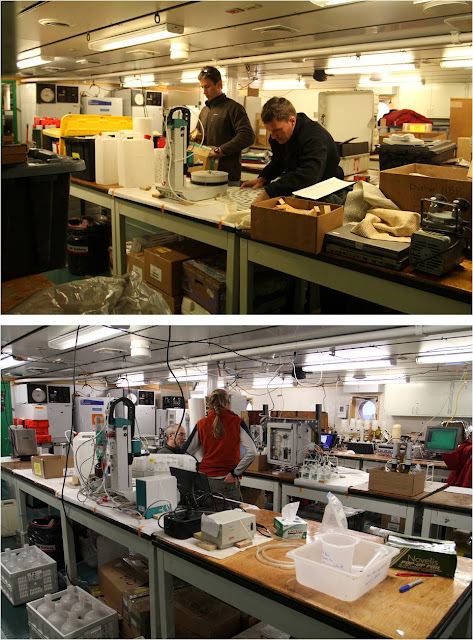Boarding the Nathaniel
B. Palmer
The Palmer rolled in to McMurdo on Saturday, February 9thth.
The people on the previous cruise were packing up the last of their boxes
so we had to wait until Sunday the 10th before we could move our gear
on. I had started that morning off with
the McMurdo Marathon. As soon as I finished,
I stiffly made my way to the Palmer to begin finding all of my boxes scattered
around the ship. Where are my chemicals? Where are my crates? Where are my
requested supplies? I need this, I need that, help! Amy and Jamee were the two
people we could get help from and they had their hands FULL. Some items we had
shipped down from home had been repackaged upon boarding the Palmer so it made
it a bit tricky playing this game of hide-and-seek. Tiny moments of panic
pulsed through my heart when I couldn’t find something. If I don’t find this,
I’m screwed for the next 53 days! Luckily, I found everything. These ladies did
a graceful job at getting everyone accommodated within that short time-frame
and our February 12th departure date looked promising.
We were slightly delayed for departure because of a fuel
mishap. A fuel tanker (large green ship with large tubing) came in to McMurdo
to fill the Palmer up with diesel. It was only then that we realized that that same
tanker had filled a Russian ship earlier in the day, and had given them 55,000
EXTRA gallons of fuel. Was this an accident or political bribery? Just to put
the numbers in perspective: It takes 435,000 gallons to fill the Palmer. At
$4/gallon, that means it takes $1.7 million to fill. If the Russian vessel took
55,000 extra gallons then that cost us roughly 10 days in fuel time. They could
have at least offered to compensate us in vodka! We couldn’t leave port until we
somehow got that extra fuel in to our ship. We were fortunate enough to
“borrow” fuel from McMurdo station’s reserve. That just means their supply is
now cut for their winter-over. Hopefully they’ll have enough! Either way, running
research vessels is a spendy operation! For the record, it’s about ~$60,000 a
day to run this vessel. I believe, when scientists write a grant, they request
the amount of ship time they need and then NSF pays for that portion in
addition to giving the scientists the grant money they need to run their
science.
When we boarded, we came upon rooms with empty counter tops.
It was our job to find everything and set it all up. This image shows the transformation
of the lab space from before (first photo) to after (second photo). We had to
use power tools to drill wood blocks and eyelets in to the counter tops to
strap everything down securely. There was no one to do this work for you. You
had to be self-sufficient.
Photo Credit: A. Margolin
If you didn’t secure things down properly, you risked having
all of it come tumbling to the floor when the boat hit a big swell.
We each had to set up all of our own equipment. See this machine: a fluorometer. It measures
fluorescence.

fluorescence.

I have never done anything more than stick a glass tube in
it and write down the number it gives. On this day, I had to learn how to
change out filters, lamps, calibrate it to my needs and make sure it was
working properly. Thankfully there exists in the world people who write up the
detailed manuals of how to operate equipment.
Rooms to hang in
At first it was a bit disorienting to navigate my way around
the interior of the ship. It seemed so big! With 280 feet in length, 7 levels,
and a plethora of rooms, people could be anywhere! I had to get my bearings and
I soon did. The bridge, the ice-tower, the conference room, the lounges, the gym,
the helo hanger where the treadmill is, the sauna, the laundry room, microscope
room, galley, labs, bathroom, cabin, etc.!
Back in Scott’s day of 1900’s they just had ONE room—and
they built the hut to keep things cold!
It is here, on this floating lab, our only home away from
home, that we will spend the next 53 days. From February 12th until
April 6th,we will cruise around the most extreme inhospitable place
on earth with limited communication to the outside world.
Welcome aboard!
-Allison








No comments:
Post a Comment